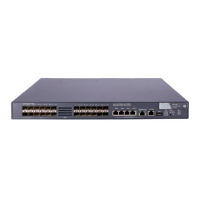30
Task Command Remarks
Display the load sharing mode for
IRF links.
display irf-port load-sharing
mode
[
irf-port
[ member-id/port-number ] ] [
|
{
begin
|
exclude
|
include
}
regular-expression ]
Available in any view.
Display the master/subordinate
switchover state of IRF members.
display switchover state
[
slot
member-id ] [
|
{
begin
|
exclude
|
include
} regular-expression ]
Available in any view.
Display MAD configuration.
display mad
[
verbose
] [
|
{
begin
|
exclude
|
include
}
regular-expression ]
Available in any view.
Configuration examples
This section provides IRF configuration examples for IRF fabrics that use different MAD
mechanisms.
LACP MAD-enabled IRF configuration example
Network requirements
As shown in Figure 13, set up a two-member IRF fabric at the access layer of the enterprise network.
Configure LACP MAD on the multichassis aggregation to Device C (an HPE device that supports
extended LACP).
Figure 13 Network diagram
Configuration procedure
This example assumes that the system names of Device A, Device B, and Device C are DeviceA,
DeviceB, and DeviceC respectively before the IRF fabric is formed.
1. Assign member IDs:
# Keep the default member ID of Device A unchanged.
# Change the member ID of Device B to 2.
XGE1/0/25
(IRF-port1/2)
XGE2/0/26
(IRF-port2/1)
GE1/0/2
GE2/0/1
Device A Device B
GE1/0/1 GE1/0/2
IRF
IP network
Device C

